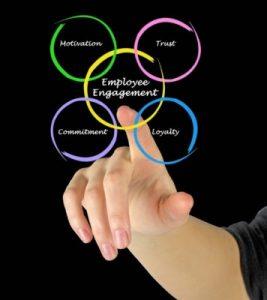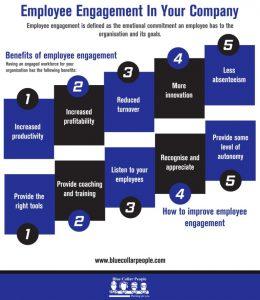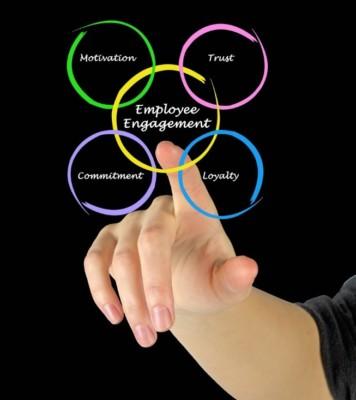Employee engagement is defined as the emotional commitment an employee has to the organisation and its goals. Because they’re emotionally committed,  engaged employees actually care about the company as well as their role in it. As a result, these employees don’t just work for a paycheque, or just because they want to earn a promotion, they work because they want to contribute to the organisation’s success.
engaged employees actually care about the company as well as their role in it. As a result, these employees don’t just work for a paycheque, or just because they want to earn a promotion, they work because they want to contribute to the organisation’s success.
When an employee cares – i.e. they’re engaged – they put in discretionary effort. This means that the employee will be willing to go out of their way to get the job done to the best of their ability even when their boss is not watching. An engaged worker, for example, will be willing to work overtime even without being asked.
Happiness and satisfaction don’t equal engagement
Employee satisfaction and happiness should not be taken to mean that employees are engaged. An employee could be happy at work, but that doesn’t necessarily mean they’re working hard and productively on the organisation’s behalf.
Similarly, a satisfied employee could show up to her job diligently without complaint but would never go the extra mile for the organisation of their own volition. They’d probably not hesitate to take up another job that promises a 10% bump in pay if a headhunter came calling. Simply put, happiness and satisfaction cannot be substitutes for engagement.
(Source: forbes.com)
Benefits of employee engagement
Having an engaged workforce for your organisation has the following benefits:
- Increased productivity. Employees who are engaged generally work harder, faster and more passionately because they like doing their job. It’s a no-brainer; when you are interested and connected to what you are doing, you’re more likely to do it to the best of your ability. The more engaged your employees are, the more efficient and driven to succeed they will be.
- Increased profitability. Of course, if your employees are working harder and more passionately, they will produce quality work which at the endpoint will please your customers. Happy customers come back and refer other customers to your business. The increase in sales will translate into increased profitability for your company.
- Reduced turnover. Another benefit of having an engaged workforce is increased employee retention. Engaged employees are not only invested in the success of the organisation but are also loyal. This significantly reduces their chances of leaving your organisation if/when other opportunities come along.
- More innovation. Employees who are engaged in their work perform at a higher level, bringing passion and interest into their jobs. This will often lead to innovation in the workplace whereby your employees continuously strive to efficiently create new processes, services, and products.
- Less absenteeism. Engaged employees believe they have a role to play in the success of the company and will, therefore, be less likely to miss work if there isn’t a genuine reason for them to do so. Additionally, they’ll also get more work done when they come into work as compared to disengaged employees.
While there’s no doubt that employee engagement is tremendously beneficial to any business, a report by Gallup titled State of the Global Workplace indicates that only about 13% of employees in the world are engaged in their jobs. This makes employee engagement a serious problem that managers and leaders need to tackle to ensure success for their businesses.
A vast majority of leaders agree that the employees are the most important assets to any company. But in reality, this is only true when the majority of the workforce is fully engaged in their work. If they’re not, the employees are either adding minimal value to the operation or actively working against their organisation.
How to improve employee engagement
There’re several things you can do to enhance employee engagement in your organisation. These are:
- Provide the right tools
One of the most effective ways of improving engagement – and probably one of the most overlooked – is ensuring that your employees have all the tools they require to succeed in their roles. You need to provide your people with the enabling infrastructure to get the job done.
Enabling infrastructure includes all the tools and processes employees use to complete their work as well as the organisational capabilities that are at their disposal. You not only have to provide physical tools but also create a conducive work environment by eliminating bureaucratic barriers that could frustrate employees as they go about their day-to-day work. - Provide coaching and training
Create a culture that fosters the continuous development of employees. This not only helps them acquire and improve the skills they need for their jobs but also demonstrates to them that the organisation values them and believes in their potential. If your employees feel that the company is investing in their future, their level of engagement will increase.
Fortunately, you don’t require a huge budget to put in place a meaningful employee development program. A simple thing like cross-training – where employees learn how to do the jobs of their colleagues – can be pretty effective. Managers and leaders can also help develop employees by providing coaching and mentoring. This not only enables you to keep your employees engaged but will also help you attract top talent to your organisation. - Listen to your employees
Effective leaders listen closely to what their workers have to say and then take action on the feedback they receive. Encourage your employees to come forward if they have concerns they would like to air. You can do this, for example, by instituting an open door policy whereby employees can freely interact with their managers and supervisors.
Also, ask for the input of your employees when making major company decisions such as changing processes and procedures. Listening to your employees not only helps you identify problems in the organisation that need to be addressed but also makes your people feel that their views are valued. - Recognise and appreciate
Recognising and rewarding exemplary workers can go a long way in improving employee engagement. Show your employees that you genuinely appreciate the hard work they have done and they’ll in turn work harder and become more passionate about their job.
Rewards for outstanding employees don’t have to be monetary or expensive. Acknowledging their hard work in front of their peers is often all that is needed. Recognition motivates the outstanding individuals to keep working hard and also serves to boost engagement throughout the organisation. People always respond to being appreciated. - Provide some level of autonomy
Allowing your employees some level of flexibility in how they do their job will help them achieve a balance between their work and personal lives. Work-life balance is a key ingredient to employee engagement and should, therefore, be prioritised.
Give your employees the freedom to decide when and how they are going to complete their tasks. If an employee would like to come in early and leave early on some days, you should be able to accommodate this provided the job is getting done as it should be. Allowing workers to telecommute whenever possible is also another way of providing flexibility and accommodating their personal interests outside of work. Focus more on the results than on the ‘how’ to improve employee engagement.
While improving employee engagement might not seem complex, it does require prioritisation and commitment to be executed successfully. Businesses that get it right will drive better financial returns, edge out their competitors, and become a preferred employer for those seeking jobs.







